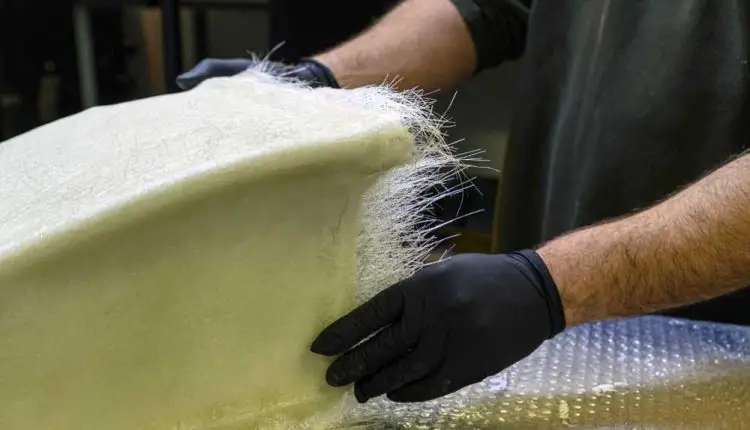How to Get Fiberglass Out of Clothes: A Complete Guide
Articles, products, and services offered on this site are for informational purposes only. We are part of the Amazon Services LLC Associates Program, an affiliate advertising program. Amazon.com is compensated for sales resulting from links on our website.
Please review our disclaimer before acting based on anything you read or see.
Fiberglass, a synthetic material made of fine glass fibers, is widely used in various industries due to its strength and insulation properties. However, it can be a nuisance when embedded in our clothes. Understanding the dangers associated with fiberglass contamination is crucial for taking the necessary precautions and effectively removing it from your garments.
When fiberglass comes into contact with your skin, it can cause irritation, redness, and itching. The tiny glass fibers can easily penetrate the skin, leading to discomfort and potential health risks.
Inhaling fiberglass particles can cause respiratory problems, including coughing, wheezing, and difficulty breathing. Therefore, handling fiberglass with care and taking appropriate measures to protect yourself before attempting to remove it from your clothes is essential.
Precautions to Take Before Removing Fiberglass from Clothes
Before jumping into removing fiberglass from your clothes, it is crucial to take certain precautions to minimize the risk of further contamination and protect your health. Follow these steps to ensure your safety:
Wear Protective Gear
Before handling fiberglass-contaminated clothes, wear disposable gloves, a face mask, and safety goggles. This will prevent direct contact with the fiberglass particles and minimize the chances of inhalation.
Isolate the Affected Garments
Remove the contaminated clothes from your regular laundry and place them in a separate bag or container. This will prevent the spread of fiberglass to other garments and minimize the risk of recontamination.
Avoid Agitation
Fiberglass particles can become more airborne if you vigorously shake or agitate the contaminated clothes. Handle them gently to prevent further dispersion of the fibers.
Ventilate the Area
When dealing with fiberglass, it is crucial to have proper ventilation. Open windows or use fans to create a draft that will help disperse any airborne fibers. This will reduce exposure and aid in the removal process.
How to Get Fiberglass Out of Clothes
Now that you have taken the necessary precautions,, let’s dive into the step-by-step guide on safely removing fiberglass from your clothes. Follow these five steps carefully to ensure effective removal without risking your health:
Shake Off Excess Fiberglass
Take the contaminated garment outside and give it a good shake. This will help remove any loose fiberglass particles clinging to the fabric. Be cautious while doing this to avoid inhaling the fibers. Additionally, avoid shaking the garment vigorously, as it could further embed the fibers into the fabric.
Use Sticky Tape or Lint Roller
After gently shaking off the excess fiberglass, use a piece of sticky tape or a lint roller to dab the affected areas. Press the tape or roller against the fabric and peel it off slowly. The sticky surface attracts and pulls the remaining fiberglass particles from the clothes. Repeat this process until you see no visible fibers on the tape or roller.
Rinse with Cold Water
Once you have removed as much fiberglass as possible using sticky tape or a lint roller, rinse the contaminated garment with cold water. The cold temperature will help prevent the fibers from embedding further into the fabric. Avoid using hot water, as it can cause the fibers to melt and stick to the clothes.
Wash Separately
After rinsing, wash the contaminated garment separately from your regular laundry. Use a gentle detergent and set the washing machine to a cold water cycle. This will ensure that any remaining fiberglass particles are removed from the fabric. After the wash, inspect the clothes for any visible fibers. If you still notice fiberglass, repeat the rinsing and washing process.
Dry and Inspect
Once the contaminated garment has been washed, allow it to air dry. Avoid using a dryer, as the heat can cause the fibers to become more embedded in the fabric. After drying, carefully inspect the clothes for any remaining fiberglass particles. Repeat the rinsing and washing process if you find any until the garment is fiberglass-free.
My Opinion
Removing fiberglass from clothes can be tedious, but following the steps outlined in this guide can safely and effectively eliminate the irritating fibers. Always take the necessary precautions to protect your skin and respiratory system before handling fiberglass-contaminated garments.
To prevent future fiberglass contamination, consider wearing protective clothing, such as coveralls or long sleeves, when working with fiberglass. Regularly clean your work area and tools to minimize the chances of fibers sticking to your clothes. By staying cautious and implementing preventive measures, you can reduce the risk of fiberglass-related irritation and keep your clothes free from these pesky fibers.


Comments are closed.